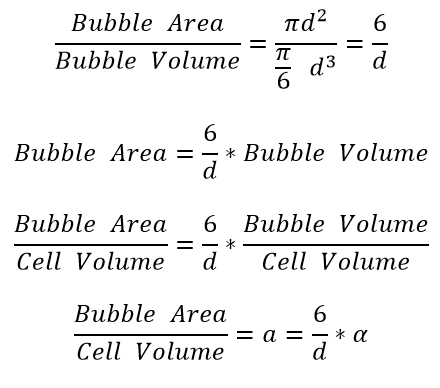-
-
July 13, 2023 at 7:18 pm
kavatar
SubscriberDear Experts,
Your help is needed again to clearify a doubt in unit of source term of gas-liquid mass transfer. Requesting your attention.
/*****Problem description*****/
Transfer of CO2 from gas mixture (CO2+O2+N2) to liquid mixture (CO2+H2O).
Species transport equation in multiphase flow (ref. fluent theory guide)
Unit of first term in this equation
Therefore, Unit for every term in the species transport equation should be the same, i.e., mass of the transferring species per unit cell volume per unit time
Now, Let's look at the last term: From the literature it has the following form using Henry's law:
In this k is mass transfer coefficient (m/s), a is area density (1/m) and He is unit less Henry's constant.
Therefore, the unit of mass transfer rate term can be computed as:
Which is similar to
My doubt- Unit of mass transfer rate, calculated in this way, is not simiilar to the unit of first term. In first term denominator has "cell volume" while in mass transfer rate "phase volume" appears in the denominator.
Question: Can anyone tell me if the mass transfer rate calculated from the above formula is correct. Or should it involve phase volume fraction also ? For example, it should have a form like
I have written the following two code line in the DEFINE_MASS_TRANSFER udf
According to formula-1->
k*a*(He*C_R(cell,gas)*C_YI(cell,gas,0)-C_R(cell,liq)*C_YI(cell,liq,0));
According to formula-2->
k*a*(He*C_R(cell,gas)*C_YI(cell,gas,0)*C_VOF(cell,gas)-C_R(cell,liq)*C_YI(cell,liq,0)*C_VOF(cell,liq));
Kindly suggest which of the above code will give me correct gas-liquid mass transfer rate?
-
July 14, 2023 at 2:30 pm
Prashanth
Ansys EmployeeHi,
Can you share the literature which you refer to?
-
July 14, 2023 at 3:04 pm
kavatar
SubscriberHello Prashanth,
Please find the papers (doi) and links from where the first formula is taken:
https://doi.org/10.1016/j.ces.2007.01.065
https://doi.org/10.1016/j.ces.2018.01.009
https://ris.utwente.nl/ws/portalfiles/portal/5529968/numerical_modeling.pdf
https://www.hzdr.de/publications/PublDoc-10321.pdf
Also, researchers who are using population balance to study mass transfer. For example,
https://doi.org/10.1016/j.ijmultiphaseflow.2012.09.005
In this papers the (phi_b_dot) represent mass transfer rate, which is written in the form of molar concentration (not in the form of species fraction), that i similar to first formula.
I can share more papers also where first formula is applied without taking volume fraction into consideration. So, I think everyone cannot be wrong. But I am not able to figure out why volume fraction is not a part of mass transfer rate.
Any lead will helpful
Thanks in advance
Sincerely
Krishna
-
July 18, 2023 at 8:34 pm
kavatar
SubscriberHello Prashanth (and Other Field Experts),
To be more specific, I have added page numbers where gas-liquid mass transfer formula is given.
https://doi.org/10.1016/j.ces.2007.01.065 (Page-7, left column)
https://doi.org/10.1016/j.ces.2018.01.009 (Page-4, at bottom right corner)
https://www.hzdr.de/publications/PublDoc-10321.pdf (Page-9, at the bottom)
https://ris.utwente.nl/ws/portalfiles/portal/5529968/numerical_modeling.pdf (Page-4, left column)
Any lead? whether volume fraction of phase should appear or not in mass transfer rate?
Kindly respond
-
July 19, 2023 at 10:43 am
Rob
Forum ModeratorI'd always go with the Fluent manual as the experimental approaches don't have cells. In terms of the models, https://ansyshelp.ansys.com/account/Secured?returnurl=/Views/Secured/corp/v231/en/flu_udf/flu_udf_MultiphaseDEFINE.html%23flu_udf_sec_define_mass_transfer covers the macro and has an example of a boiling liquid.
-
July 19, 2023 at 11:16 am
kavatar
SubscriberHello Rob,
Thanks again for your time. Are you talking about this UDF:
/* UDF to define a simple mass transfer based on Saturation Temperature. The "from" phase is the gas and the "to" phase is the liquid phase */ #include "udf.h" DEFINE_MASS_TRANSFER(liq_gas_source, cell, thread, from_index, from_species_index, to_index, to_species_index) { real m_lg; real T_SAT = 373.15; Thread *gas = THREAD_SUB_THREAD(thread, from_index); Thread *liq = THREAD_SUB_THREAD(thread, to_index); m_lg = 0.; if (C_T(cell, liq) >= T_SAT) { m_lg = -0.1*C_VOF(cell,liq)*C_R(cell,liq)* fabs(C_T(cell,liq)-T_SAT)/T_SAT; } if ((m_lg == 0. ) && (C_T(cell, gas) <= T_SAT)) { m_lg = 0.1*C_VOF(cell,gas)*C_R(cell,gas)* fabs(T_SAT-C_T(cell,gas))/T_SAT; } return (m_lg); }
This includes phase volume fraction in the code. The coefficient 0.1 has unit of (1/s). Therefore, the unit of mass transfer rate from this UDF is consistent with the unit of first term.
(mass of species per unit cell volume per unit time)
So you suggest me to include volume fraction in the rate? And follow
-
July 19, 2023 at 12:18 pm
Rob
Forum ModeratorThat's the one. No comment re the equation - the solver knows how much material is in the cell and I tend to leave the theory at that level to developers!
-
July 19, 2023 at 12:59 pm
kavatar
SubscriberDear Rob,
Thank you for your time. I will try to simulate accordingly.
-
August 2, 2023 at 6:47 pm
kavatar
SubscriberHello Everyone (And Rob),
I have resolved the above issue. I wanted to post the answer so if anyone comes across this thread, he/she is not misled by our discussion.
Answer- Formula1 (without multiplication of volume fraction) gives the true gas-liquid mass transfer.
Explaination- The idea lies in the definition of area density “a” which is area of the bubble (or interface in case of VOF) per unit cell volume. In the Euler-Euler multiphase model this is calculated as following:
Therefore, the unit of area density “a” in the mass transfer rate is:
Which I took as (1/m) in my previous explaination. Hence, the multiplication of phase volume fraction is already a part of area density definition which makes the unit of mass transfer rate as “mass of the transferring species per unit cell volume per unit time”. So the correct mass transfer formula is:
which is same as frequently used in the literature. (Any comment on the above explaination is welcome, if anyone finds it wrong)
Thanks everyone
Regards
Krishna
-
- The topic ‘Gas-Liquid Mass Transfer Source Term (CO2 transfer from gas to Liquid water)’ is closed to new replies.



-
4613
-
1520
-
1386
-
1209
-
1021

© 2025 Copyright ANSYS, Inc. All rights reserved.

















